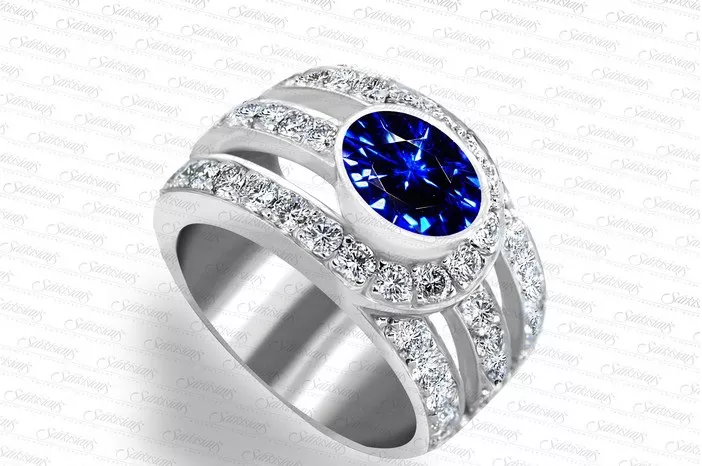Yellow sapphire, a gemstone renowned for its vibrant color and hardness, is highly valued in the jewelry industry. Assessing the purity of yellow sapphire involves a combination of visual inspection, scientific testing, and understanding of gemological principles. This guide provides a detailed introduction to the process, ensuring clarity and accuracy for both professionals and enthusiasts alike.
Understanding Yellow Sapphire
Yellow sapphire belongs to the corundum family, which includes rubies and other colored sapphires. Its hardness, ranking second only to diamonds on the Mohs scale, makes it durable and suitable for jewelry. The color of yellow sapphire ranges from pale yellow to vivid orange-yellow, with purity often determined by the intensity and uniformity of its hue.
Visual Inspection
1. Color Evaluation
Color is the most striking feature of yellow sapphire. Pure yellow sapphires exhibit a vivid, even color with minimal color zoning. Color zoning refers to variations in color intensity within the gemstone, which can affect its purity. High-purity yellow sapphires tend to have a more uniform color distribution.
2. Clarity Assessment
Clarity involves examining the internal characteristics of the gemstone, known as inclusions. Inclusions can be natural or formed during the gemstone’s growth process. High-purity yellow sapphires have minimal to no visible inclusions, which can affect their transparency and overall appearance.
3. Cut and Polish
The cut and polish of a yellow sapphire can enhance its color and clarity. A well-cut gemstone allows light to reflect and refract optimally, enhancing its brilliance and fire. Poorly cut sapphires may appear dull or have uneven surfaces, which can obscure their true color and clarity.
Scientific Testing
1. Spectroscopy
Spectroscopy is a non-destructive testing method used to analyze the chemical composition of gemstones. By exposing the yellow sapphire to various wavelengths of light, spectroscopists can identify specific absorption patterns unique to sapphires. These patterns help confirm the gemstone’s authenticity and provide insights into its purity.
2. Refractometry
Refractometry measures the refractive index of the gemstone, which is a measure of how much light bends when it enters the gemstone. Yellow sapphires have a specific refractive index range. By measuring this, gemologists can confirm whether the gemstone is a sapphire and assess its purity based on deviations from the expected range.
3. Density Testing
Density testing involves measuring the weight of the gemstone relative to its volume. Yellow sapphires have a specific density range. By comparing the measured density to the expected range, gemologists can further verify the gemstone’s authenticity and purity.
4. Ultraviolet Fluorescence
Some gemstones exhibit fluorescence when exposed to ultraviolet light. Yellow sapphires may show varying degrees of fluorescence, which can provide additional clues about their purity. While fluorescence is not a definitive test for purity, it can be used in conjunction with other tests to gain a more comprehensive understanding of the gemstone’s characteristics.
5. Heat Treatment Detection
Many yellow sapphires undergo heat treatment to enhance their color and clarity. While heat treatment is a common and accepted practice, it can affect the gemstone’s purity and value. Gemologists use advanced techniques, such as spectroscopy and microscopic examination, to detect signs of heat treatment and assess its impact on the gemstone’s purity.
Gemological Certification
Gemological certification is a crucial step in verifying the purity and authenticity of yellow sapphires. Certified gemologists use a combination of visual inspection and scientific testing to evaluate the gemstone and issue a detailed report. This report includes information on the gemstone’s color, clarity, cut, carat weight, and any treatments it may have undergone.
When choosing a gemological laboratory, look for one with a good reputation and accreditation from recognized gemological organizations. These laboratories employ highly trained gemologists who use state-of-the-art equipment to ensure accurate and reliable results.
Common Impurities and Treatments
1. Impurities
Natural impurities, such as iron and titanium, can affect the color and clarity of yellow sapphires. High concentrations of these impurities can result in darker or less vibrant colors, reducing the gemstone’s purity and value.
2. Diffusion Treatment
Diffusion treatment involves exposing the gemstone to high temperatures and pressures to enhance its color. While this treatment can produce striking colors, it can also affect the gemstone’s stability and durability, potentially reducing its purity over time.
3. Dyeing and Coating
Some unscrupulous dealers may attempt to enhance the color of yellow sapphires through dyeing or coating. These treatments are not permanent and can easily fade or wear off, revealing the gemstone’s true color and reducing its value.
Conclusion
In summary, checking the purity of yellow sapphire is a multi-faceted process requiring expertise and advanced technology. By following these guidelines, gemologists and consumers alike can ensure they are working with genuine, high-quality gemstones.
Related topic:
- Yellow Sapphire Benefits for Women
- How to Inject Energy into Yellow Sapphires?
- How to Check the Purity of Yellow Sapphire?


